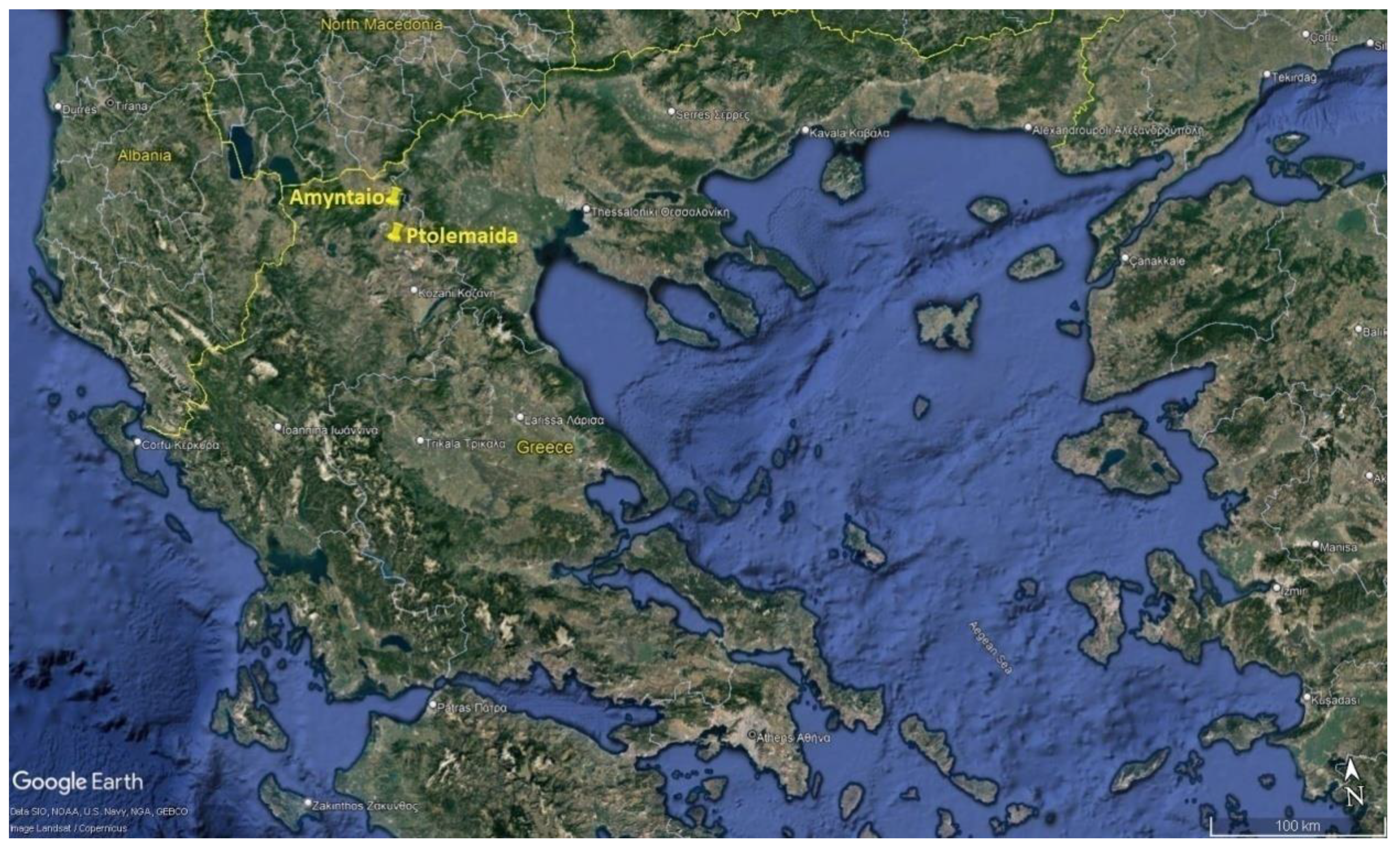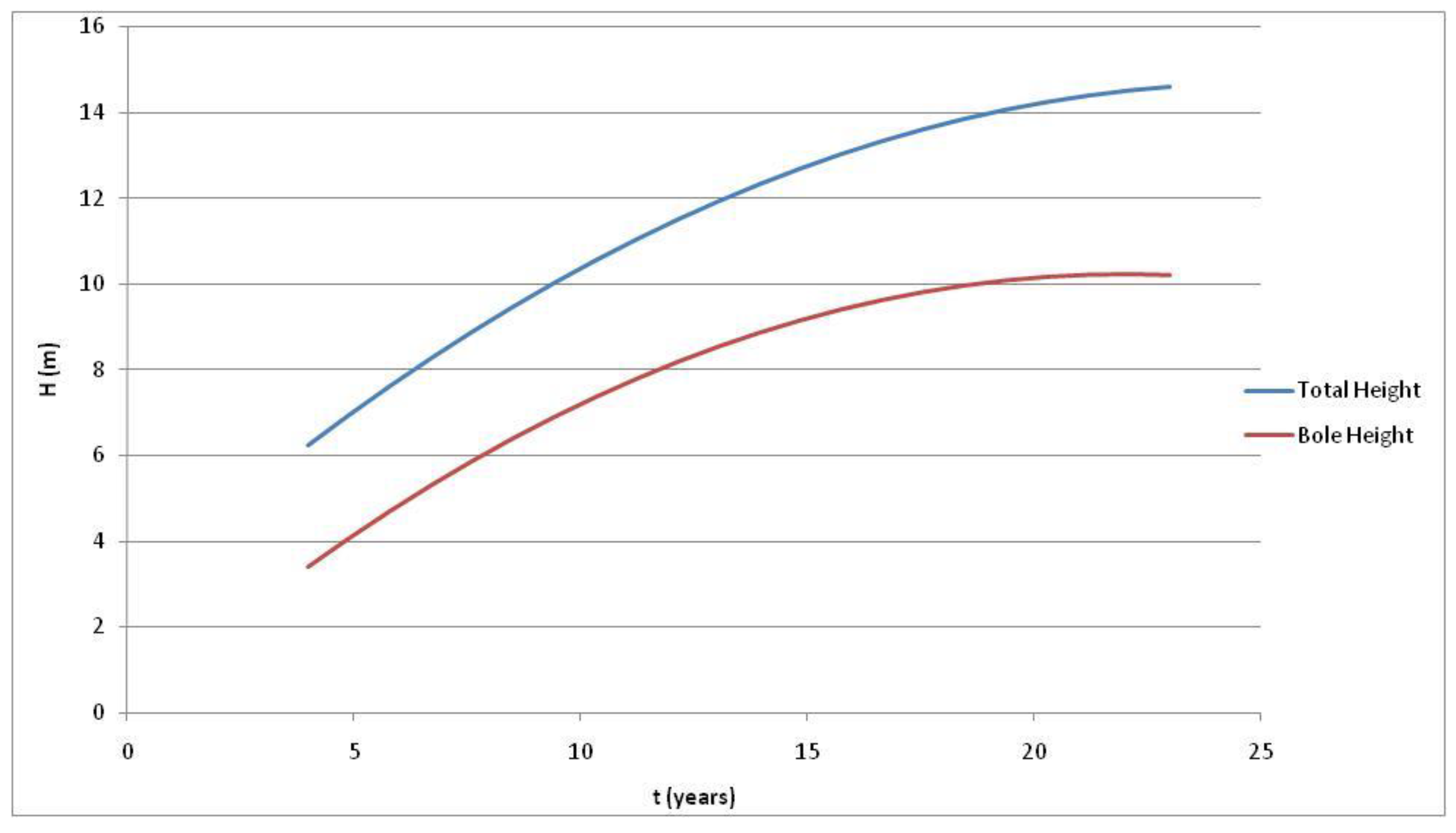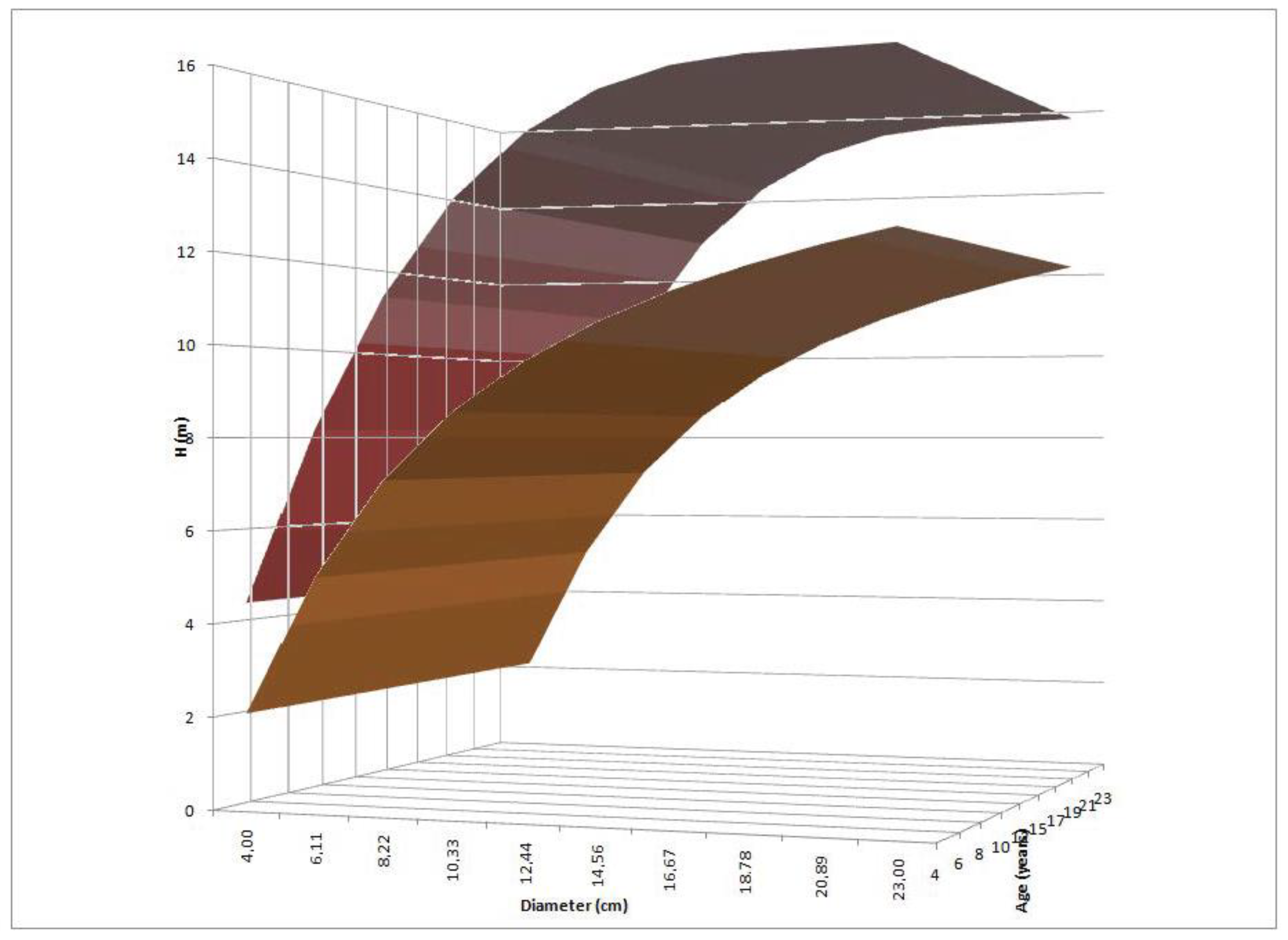Allometric Models for Estimating the Height of Robinia pseudoacacia L. in Restoration Plantations
Abstract
1. Introduction
2. Materials and Methods
2.1. Study Area
2.2. Input Data
2.3. Fitted Models
2.4. Comparison Criteria for the Fitted Models
3. Results
3.1. Height–Age Models
3.2. Height–Diameter Models
4. Discussion
5. Conclusions
Author Contributions
Funding
Institutional Review Board Statement
Informed Consent Statement
Data Availability Statement
Acknowledgments
Conflicts of Interest
References
- Sikkema, R.; Proskurina, S.; Banja, M.; Vakkilainen, E. How can solid biomass contribute to the EU’s renewable energy targets in 2020, 2030 and what are the GHG drivers and safeguards in energy- and forestry sectors? Renew. Energy 2021, 165, 758–772. [Google Scholar] [CrossRef]
- Xu, Z.; Smyth, C.; Lempriere, T.; Rampley, G.J.; Kurz, W.A. Climate change mitigation strategies in the forest sector: Biophysical impacts and economic implications in British Columbia, Canada. Mitig. Adapt. Strat. Glob. Chang. 2018, 23, 257–290. [Google Scholar] [CrossRef]
- Lelieveld, J.; Klingmüller, K.; Pozzer, A.; Burnett, R.T.; Haines, A.; Ramanathan, V. Effects of fossil fuel and total anthropogenic emission removal on public health and climate. Proc. Natl. Acad. Sci. USA 2019, 116, 7192–7197. [Google Scholar] [CrossRef]
- Silva, L.N.; Freer-Smith, P.; Madsen, P. Production, restoration, mitigation: A new generation of plantations. New For. 2018, 50, 153–168. [Google Scholar] [CrossRef]
- Pleguezuelo, C.R.R.; Zuazo, V.H.D.; Bielders, C.; Bocanegra, J.A.J.; PereaTorres, F.; Martínez, J.R.F. Bioenergy farming using woody crops. A review. Agron. Sustain. Dev. 2015, 35, 95–119. [Google Scholar] [CrossRef]
- Burns, R.M.; Honkala, B.H.; United States. Forest Service. Silvics of North America. Silvics of North America. Volume 2, Hardwoods. In Agriculture Handbook 654; U.S. Government Printing Office: Washington, DC, USA, 1990. [Google Scholar]
- Keresztesi, B. Breeding and cultivation of black locust, Robinia pseudoacacia, in Hungary. For. Ecol. Manag. 1983, 6, 217–244. [Google Scholar] [CrossRef]
- Cierjacks, A.; Kowarik, I.; Joshi, J.; Hempel, S.; Ristow, M.; von der Lippe, M.; Weber, E. Biological Flora of the British Isles: Robinia pseudoacacia. J. Ecol. 2013, 101, 1623–1640. [Google Scholar] [CrossRef]
- Vítková, M.; Pergl, J.; Sádlo, J. Black locust: From global ecology to local management—A case study from the Czech Republic. In Introduced Tree Species in European Forests: Opportunities and Challenge; Krumm, F., Vítková, L., Eds.; European Forest Institute: Joensuu, Finland, 2016; pp. 306–318. [Google Scholar]
- Vítková, M.; Müllerová, J.; Sádlo, J.; Pergl, J.; Pyšek, P. Black locust (Robinia pseudoacacia) beloved and despised: A story of an invasive tree in Central Europe. For. Ecol. Manag. 2017, 384, 287–302. [Google Scholar] [CrossRef]
- Rédei, K.; Csiha, I.; Keserű, Z.; Ágnes, K.V.; Gyori, J. The Silviculture of Black Locust (Robinia pseudoacacia L.) in Hungary: A Review. South-East Eur. For. 2011, 2, 101–107. [Google Scholar] [CrossRef]
- Dini-Papanastasi, O.; Panetsos, C.P. Relation between growth and morphological traits and genetic parameters of Robinia pseudoacacia var. monophylla D.C. in Northern Greece. Silvae Genet. 2000, 49, 37–44. [Google Scholar]
- Radtke, A.; Ambraß, S.; Zerbe, S.; Tonon, G.; Fontana, V.; Ammer, C. Traditional coppice forest management drives the invasion of Ailanthus altissima and Robinia pseudoacacia into deciduous forests. For. Ecol. Manag. 2013, 291, 308–317. [Google Scholar] [CrossRef]
- Papaioannou, A.; Chatzistathis, T.; Papadopoulos, G. Robinia pseudοacacia as a valuable invasive species for the restoration of degraded croplands. Catena 2016, 137, 310–317. [Google Scholar] [CrossRef]
- Campagnaro, T.; Nascimbene, J.; Tasinazzo, S.; Trentanovi, G.; Sitzia, T. Exploring patterns, drivers and structure of plant community composition in alien Robinia pseudoacacia secondary woodlands. iForest—Biogeosci. Forest 2018, 11, 586–593. [Google Scholar] [CrossRef]
- Barrett, R.P.; Mebrahtu, T.; Hanover, J. Black locust: A multi-purpose tree species for temperate climates. In Advances in New Crops: Proceedings of the First National Symposium NEW CROPS, Research, Development, Economics, Indianapolis, Indiana, 23–26 October 1988; Janick, J., Simon, J.E., Eds.; Timber Press: Portland, OR, USA, 1990; pp. 278–283. [Google Scholar]
- Bongarten, B.C.; Huber, D.A.; Apsley, D.K. Environmental and genetic influences on short-rotation biomass production of black locust (Robinia pseudoacacia L.) in the Georgia Piedmont. For. Ecol. Manag. 1992, 55, 315–331. [Google Scholar] [CrossRef]
- Papanastasis, V.P.; Platis, P.D.; Dini-Papanastasi, O. Effects of age and frequency of cutting on productivity of Mediterranean deciduous fodder tree and shrub plantations. For. Ecol. Manag. 1998, 110, 283–292. [Google Scholar] [CrossRef]
- Böhm Ch Quinkenstein, A.; Freese, D. Yield prediction of young black locust (Robinia pseudoacacia L.) plantations for woody biomass production using allometric relations. Ann. For. Res. 2011, 54, 215–227. [Google Scholar]
- Rédei, K.; Csiha, I.; Keseru, Z. Black locust (Robinia pseudoacacia L.) short-rotation crops under marginal site conditions. Acta Silv. Lignaria Hung. 2011, 7, 125–132. [Google Scholar]
- Carl, C.; Lehmann, J.R.K.; Landgraf, D.; Pretzsch, H. Robinia pseudoacacia L. in Short Rotation Coppice: Seed and Stump Shoot Reproduction as well as UAS-based Spreading Analysis. Forest 2019, 10, 235. [Google Scholar] [CrossRef]
- Nicolescu, V.-N.; Buzatu-Goanță, C.; Bartlett, D.; Iacob, N. Regeneration and Early Tending of Black Locust (Robinia pseudoacacia L.) Stands in the North-West of Romania. South-East Eur. For. 2019, 10, 97–105. [Google Scholar] [CrossRef]
- Arianoutsou, M.; Bazos, I.; Delipetrou, P.; Kokkoris, Y. The alien flora of Greece: Taxonomy, life traits and habitat preferences. Biol. Invasions 2010, 12, 3525–3549. [Google Scholar] [CrossRef]
- Jaber, Y.; Radoglou, K.; Tziaferidis, S.R.; Xanthopoulos, G.; Spyroglou, G.; Fotelli, M.N. Effects of symbiotic N fixation and resprouting on the photosynthetic performance of black locust seedlings. In Proceedings of the HELECOS 10 Ecology and the Conservation of Nature: Advances and Retreats in an Age of Crisis, online, 14–17 October 2021; p. 231, Hellenic Ecological Society. Available online: https://helecos10.gr/wp-content/uploads/2021/12/helecos10-proceedings-final.pdf (accessed on 30 January 2021).
- Panagopoulos, T.; Hatzistathis, A. Early growth of Pinus nigra and Robina pseudoacacia stands: Contributions to soil genesis and landscape improvement on lignite spoils in Ptolemaida. Landsc. Urban Plan. 1995, 32, 19–29. [Google Scholar] [CrossRef]
- Spyroglou, G.; Fotelli, M.; Nanos, N.; Radoglou, K. Assessing Black Locust Biomass Accumulation in Restoration Plantations. Forests 2021, 12, 1477. [Google Scholar] [CrossRef]
- Ainalis, A.B.; Tsiouvaras, C.N. Forage production of woody fodder species and herbaceous vegetation in a silvopastoral system in northern Greece. Agrofor. Syst. 1998, 42, 1–11. [Google Scholar] [CrossRef]
- Papachristou, T.G.; Papanastasis, V.P. Forage value of Mediterranean deciduous woody fodder species and its implication to management of silvo-pastoral systems for goats. Agrofor. Syst. 1994, 27, 269–282. [Google Scholar] [CrossRef]
- Papachristou, T.; Platis, P.; Papanastasis, V.; Tsiouvaras, C. Use of deciduous woody species as a diet supplement for goats grazing Mediterranean shrublands during the dry season. Anim. Feed Sci. Technol. 1999, 80, 267–279. [Google Scholar] [CrossRef]
- Papachristou, T.; Platis, P.D. Intake by goats browsing kermes oak alone or choices of different browse combinations: Implications for Mediterranean grazing systems. Rangel. J. 2011, 33, 221–227. [Google Scholar] [CrossRef]
- Papachristou, T.G.; Platis, P.D.; Papachristou, I.; Samara, T.; Spanos, I.; Chavales, E.; Bataka, A. How the structure and form of vegetation in a black locust (Robinia pseudoacacia L.) silvopastoral system influences tree growth, forage mass and its nutrient content. Agrofor. Syst. 2020, 94, 2317–2330. [Google Scholar] [CrossRef]
- Curtis, R.O. Height-Diameter and Height-Diameter-Age Equations For Second-Growth Douglas-Fir. For. Sci. 1967, 13, 365–375. [Google Scholar] [CrossRef]
- Huang, S.; Titus, S.J. An age-independent individual tree height prediction model for boreal spruce–aspen stands in Alberta. Can. J. For. Res. 1994, 24, 1295–1301. [Google Scholar] [CrossRef]
- Moore, J.A.; Zhang, L.; Stuck, D. Height-Diameter Equations for Ten Tree Species in the Inland Northwest. West. J. Appl. For. 1996, 11, 132–137. [Google Scholar] [CrossRef]
- Huang, S.; Price, D.; Titus, S.J. Development of ecoregion-based height–diameter models for white spruce in boreal forests. For. Ecol. Manag. 2000, 129, 125–141. [Google Scholar] [CrossRef]
- Peng, C.; Zhang, L.; Liu, J. Developing and Validating Nonlinear Height–Diameter Models for Major Tree Species of Ontario’s Boreal Forests. North. J. Appl. For. 2001, 18, 87–94. [Google Scholar] [CrossRef]
- Avery, T.E.; Burkhart, H. Forest Measurements; McGraw-Hill Science Engineering: New York, NY, USA, 2002. [Google Scholar]
- Redei, K. Akácosok FaTermése. (Yield of Black Locust Stands); FRI Research Report; FRI: Budapest, Hungary, 1984. [Google Scholar]
- Deliverable of the Project with Code T1EDK 02521. Project Title: Contribution of the Tree Planted Land of Western Macedonia Lignite Center to Protection of Environment and to Mitigation of Climate Change. Work Pack: Collection and Processing of Study Area Data. Head: PPC SA. Stakeholders Involved: DUTH, ENA. 2019. Available online: http://comit.fmenr.duth.gr/ (accessed on 13 February 2022). (In Greek).
- Platis, P.; Papachristou TSpanos, Ι.; Meliadis, I.; Kazanzidis, S.; Halivopoulos, G.; Giakzidis, G.; Mantzanas, K. Special Plant Study for the Restoration of Vegetation of the Mines in Ptolemaida, in Kozani Regional Unit, in the Context of the Environmental Impact Assessment of PPC SA; Hellenic Agricultural Organization “Dimitra”: Thessaloniki, Greece, 2011. (In Greek) [Google Scholar]
- Oliver, C.D.; Larson, B.C. Forest Stand Dynamics; John Wiley & Sons: Hoboken, NJ, USA, 1996. [Google Scholar]
- Smith, D.M.; Larson, B.C.; Kelty, M.J.; Ashton, M.S. The Practice of Silviculture: Applied Forest Ecology; John Wiley & Sons: Hoboken, NJ, USA, 1997. [Google Scholar]
- Hoyer, G.E.; Herman, F.R. Height-Age and Site Index Curves for Pacific Silver Fir in the Pacific Northwest; U.S. Department of Agriculture: Washington, DC, USA, 1989.
- IBM Corp. IBM SPSS Statistics for Windows; Version 21.0; IBM Corp: Armonk, NY, USA, 2012. [Google Scholar]
- Kitikidou, K. Applied Statistics with the Use of the SPSS Statistical Package; Springer Nature: Berlin, Germany, 2005. (In Greek) [Google Scholar]
- Yuancai, L.; Parresol, B.R. Remarks on Height-Diameter Modeling; Springer Nature: Berlin, Germany, 2001. [Google Scholar]
- Ahmadi, K.; Alavi, S.J.; Kouchaksaraei, M.T.; Aertsen, W. Non-linear height-diameter models for oriental beech (Fagus orientalis Lipsky) in the Hyrcanian forests, Iran. Biotechnol. Agron. Soc. Environ. 2013, 17, 431–440. [Google Scholar]
- Zhou, Z.; Fu, L.; Zhou, C.; Sharma, R.P.; Zhang, H. Simultaneous compatible system of models of height, crown length, and height to crown base for natural secondary forests of Northeast China. Forests 2022, 13, 148. [Google Scholar] [CrossRef]
- Rédei, K.; Csiha, I.; Keseru, Z.; Rásó, J.; Kamandiné Végh, Á.; Antal, B. Growth and yield of Black locust (Robinia pseudoacacia L.) stands in Nyírség growing region (north-east Hungary). South-East Eur. For. 2014, 5, 13. [Google Scholar] [CrossRef]
- Rédei, K.; Keserű, Z.; Csiha, I.; Rásó, J.; Honfy, V. Plantation Silviculture of Black Locust (Robinia pseudoacacia L.) Cultivars in Hungary—A Review. South-East Eur. For. 2017, 8, 151–156. [Google Scholar] [CrossRef]
- Nicolescu, V.N.; Rédei, K.; Mason, W.L.; Vor, T.; Pöetzelsberger, E.; Bastien, J.C.; Brus, R.; Benča, T.; Ðodan, M.; Cvjetkovic, B.; et al. Ecology, growth and management of black locust (Robinia pseudoacacia L.), a non-native species integrated into European forests. J. For. Res. 2020, 31, 1081–1101. [Google Scholar] [CrossRef]
- Dafis, S. Forest Ecology; Giahoudis-Giapoulis publications: Thessaloniki, Greece, 1986. (In Greek) [Google Scholar]
- Bountis, D.; Milios, E. Does crown class classification improve the initiation and development analysis of post-fire pinus brutia stands? Cerne 2017, 23, 61–68. [Google Scholar] [CrossRef][Green Version]
- Milios, E. Towards an integrated conservation vision of narrow habitat types -Silvicultural interventions. In Handbook for the Sustainable Management and Long-Term Conservation of a Narrow ENDEMIC Habitat type in a Limited Area of Occupancy—The Case of the Habitat Type 9590 *Cedrus Brevifolia Forests (Cedrosetum Brevifoliae); Eliades, N., Ed.; LIFE-KEDROS, Nature Conservation Unit, Frederick University: Frederick, Cyprus, 2021; pp. 41–52. [Google Scholar]
- Milios, E.; Petrou, P.; Pytharidis, K.; Christou, A.; Eliades, N. Assessment of how natural stand structure for narrow endemic Cedrus brevifolia Henry supports silvicultural treatments for its sustainable management. South-East Eur. For. 2021, 12, 21–34. [Google Scholar] [CrossRef]





| Mean | Standard Deviaton | Min | Max | N of Dominant * Trees | |
|---|---|---|---|---|---|
| Total height H (m) | 12.24 | 3.08 | 6.00 | 17.50 | 537 |
| Bole height Hb (m) | 8.51 | 2.67 | 2.00 | 14.00 | 537 |
| Diameter at breast height D (cm) | 12.71 | 4.30 | 3.66 | 28.81 | 537 |
| Age t (years) | 15.20 | 6.08 | 4.00 | 23.00 | 537 |
| Νο. | Model’s Name | Height–Age Models | Height–Diameter Models |
|---|---|---|---|
| 1 | Linear | ||
| 2 | Logarithmic | ||
| 3 | Inverse | ||
| 4 | Quadratic | ||
| 5 | Cubic | ||
| 6 | Power | ||
| 7 | Compound | ||
| 8 | S-curve | ||
| 9 | Logistic | ||
| 10 | Growth | ||
| 11 | Exponential |
| Criterion | Formula | Optimum Value |
|---|---|---|
| Coefficient of determination | 1 | |
| Standard error of the estimate | min | |
| Root of the mean squared error | min |
| Model | Total Height Estimation | Bole Height Estimation | ||||
|---|---|---|---|---|---|---|
| R2 | SEE | RMSE | R2 | SEE | RMSE | |
| 1 | 0.8135 | 1.3312 | 1.3275 | 0.7002 | 1.4646 | 1.4605 |
| 2 | 0.8343 | 1.2547 | 1.2512 | 0.7470 | 1.3453 | 1.3415 |
| 3 | 0.7624 | 1.5025 | 1.4983 | 0.7084 | 1.4444 | 1.4404 |
| 4 | 0.8529 | 1.1822 | 1.1852 | 0.7662 | 1.2933 | 1.2905 |
| 5 | 0.8300 | 1.2709 | 3.0994 | 0.7618 | 1.3054 | 1.6693 |
| 6 | 0.8368 | 1.2454 | 1.2443 | 0.7270 | 1.3975 | 1.4032 |
| 7 | 0.7574 | 1.5183 | 1.5469 | 0.6193 | 1.6504 | 1.7067 |
| 8 | 0.8101 | 1.3432 | 1.3552 | 0.7467 | 1.3462 | 1.3536 |
| 9 | 0.8453 | 1.2125 | 1.2139 | 0.6929 | 1.4823 | 2.4523 |
| 10 | 0.7574 | 1.5183 | 1.5464 | 0.6200 | 1.6488 | 1.7001 |
| 11 | 0.7574 | 1.5183 | 1.5465 | 0.6200 | 1.6488 | 1.7000 |
| Model | Total Height Estimation | Bole Height Estimation | ||||
|---|---|---|---|---|---|---|
| R2 | SEE | RMSE | R2 | SEE | RMSE | |
| 1 | 0.5615 | 2.0412 | 2.0355 | 0.5485 | 1.7973 | 1.7923 |
| 2 | 0.6499 | 1.8240 | 1.8189 | 0.6382 | 1.6089 | 1.6044 |
| 3 | 0.6428 | 1.8424 | 1.8373 | 0.6366 | 1.6124 | 1.6079 |
| 4 | 0.6860 | 1.7274 | 1.7250 | 0.6762 | 1.5219 | 1.5206 |
| 5 | 0.6825 | 1.7370 | 1.7851 | 0.6162 | 1.6571 | 2.3157 |
| 6 | 0.6060 | 1.9351 | 1.9514 | 0.5700 | 1.7539 | 1.7938 |
| 7 | 0.4612 | 2.2627 | 2.3567 | 0.4080 | 2.0581 | 2.2383 |
| 8 | 0.6669 | 1.7791 | 1.7826 | 0.6542 | 1.5728 | 1.5774 |
| 9 | 0.6336 | 1.8659 | 1.8874 | 0.5651 | 1.7639 | 2.1349 |
| 10 | 0.4603 | 2.2646 | 2.3661 | 0.4090 | 2.0563 | 2.2262 |
| 11 | 0.4603 | 2.2646 | 2.3662 | 0.4090 | 2.0563 | 2.2262 |
Publisher’s Note: MDPI stays neutral with regard to jurisdictional claims in published maps and institutional affiliations. |
© 2022 by the authors. Licensee MDPI, Basel, Switzerland. This article is an open access article distributed under the terms and conditions of the Creative Commons Attribution (CC BY) license (https://creativecommons.org/licenses/by/4.0/).
Share and Cite
Manolopoulos, D.; Vasileioris, K.; Milios, E.; Kitikidou, K.; Spyroglou, G.; Radoglou, K. Allometric Models for Estimating the Height of Robinia pseudoacacia L. in Restoration Plantations. Land 2022, 11, 471. https://doi.org/10.3390/land11040471
Manolopoulos D, Vasileioris K, Milios E, Kitikidou K, Spyroglou G, Radoglou K. Allometric Models for Estimating the Height of Robinia pseudoacacia L. in Restoration Plantations. Land. 2022; 11(4):471. https://doi.org/10.3390/land11040471
Chicago/Turabian StyleManolopoulos, Dimitrios, Konstantinos Vasileioris, Elias Milios, Kyriaki Kitikidou, Gavriil Spyroglou, and Kalliopi Radoglou. 2022. "Allometric Models for Estimating the Height of Robinia pseudoacacia L. in Restoration Plantations" Land 11, no. 4: 471. https://doi.org/10.3390/land11040471
APA StyleManolopoulos, D., Vasileioris, K., Milios, E., Kitikidou, K., Spyroglou, G., & Radoglou, K. (2022). Allometric Models for Estimating the Height of Robinia pseudoacacia L. in Restoration Plantations. Land, 11(4), 471. https://doi.org/10.3390/land11040471









